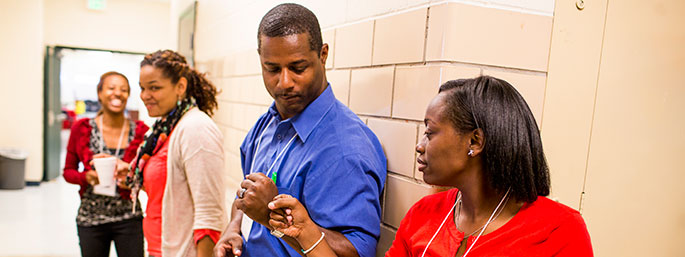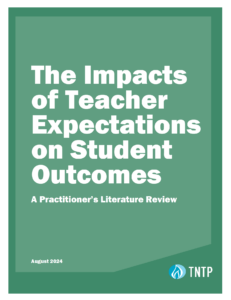Training new teachers is about skill-building: Our Fast Start training for Teaching Fellows focuses on giving first-year teachers the chance to learn the skills they’ll need to be successful in their classrooms, and then to practice those skills until they master them. We think it’s the right approach. But to learn so many challenging new skills quickly, new teachers also need the right mindset, one that lets them take constructive feedback and translate it into improved practice. The path to excellence in the classroom involves plenty of stumbles. Which raises a key question—can a growth mindset be taught?
So our ears perked up when we heard about a recent study by Claire Robertson-Kraft and Angela Duckworth, linking “grit”—defined as perseverance and passion for long-term goals—with increased effectiveness and retention for first-year teachers.
Conversation around “character education” often includes questions of how we can support students to develop grit and why it’s important to do so, particularly in high-poverty schools. But the concept of cultivating grit in teachers is a new one for many of us. Duckworth’s study made me wonder: How can we use what we know about grit to inform how we select, train and coach new teachers?
I will describe a teacher I’ll call Elyse. She struggled with classroom management at the beginning of the year—her directions weren’t clear, and she hadn’t established a strong presence in her classroom. Elyse was tired and frustrated, but she didn’t dwell on it. Instead, she invited colleagues into her classroom, then requested their feedback. She told her principal she wanted additional support. Setbacks did not deter her. She continued to stand in front of her class, trying new strategies until they worked. When they didn’t, she looked for new ones. She always believed her performance—and her students’—was mutable, and that when she faced adversity in her classroom, there were ways to push beyond it.
As Elyse’s coach, I know she’ll use tough feedback to drive her growth. So her natural grit has affected how we work together, too. In our model, teachers get active coaching in their classrooms to help them implement new skills effectively. With Elyse, I can get past nice. I can give her direct feedback about her performance, and then we can spend our time focusing on what she needs to do differently to get better results from her students.
While she once struggled to make sure she had 100 percent of her students on task, now Elyse scans her room while she teaches, making sure all the students are with her. When she sees one whose attention is wandering, she gives a quick hand signal or calls their name, refocusing them quickly without losing track of her lesson. I didn’t know Elyse before she became a Teaching Fellow, but I suspect that she’s exhibited grit in other areas of her life too—and she’s grown from coaching partly because she’s been able to draw on that capacity.
Can you bottle this kind of persistence? Probably not. But it’s worth exploring whether there are ways to capitalize on the perseverance that we all have already—to become “grittier.” Research on fostering grit in students, for example, suggests that children should be praised for qualities like working hard toward a goal, rather than intelligence. And activities that require ongoing reflection and revision are known to promote grit in students.
Surely, school leaders, coaches and peer mentors can use similar strategies to foster grit among new and developing teachers, too. Structures for giving teachers direct feedback from multiple sources, paired with guidelines for what actionable feedback looks like, are a promising start. Low-stakes opportunities to try (and sometimes fail) at new skills before standing in front of students—as our Fellows do in pre-service training—are valuable, too.
Even if we can’t manufacture grit out of nothing, identifying the seeds of “grittiness” in teacher candidates could help us recognize those who, like Elyse, will be successful in challenging classroom environments—who will be able to problem-solve creatively, face setbacks and approach teaching as a constant learning process.
It’s important to understand what grit is not. As grit has become more widely discussed in education circles, some have portrayed it as promoting indifference to student frustration or struggle. That’s not how we see it. Grit is using perseverance again and again to develop toward long-term goals, and it’s a strategy that might become a trait over time. Teachers and students alike can leverage grit to sustain their effort toward long-term goals, even when frustration or failure arises.
Our new approach to selecting and training first-year teachers opens the door for seeing these capacities in novice teachers early on. In the new model, not all teacher candidates who are accepted into pre-service training end up in the classroom. Instead, we’re relying on the pre-service training as part of the selection process; candidates who might seem weaker on paper have the chance to show great capacity for growth in the pre-service training, or vice versa. By being more flexible with our initial acceptance criteria, and then setting a high bar for successful completion of training, we have the opportunity to view prospective teachers in action and get a sense of how successfully they’re able to implement constructive feedback.
Clearly, some teachers, like Elyse, bring more natural grit than others. But as we prepare new teachers for the realities of the classroom and coach them through their first year and beyond, it’s worth considering how we can identify signs of grit early on, and then foster it and use it to drive their growth.








